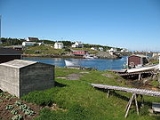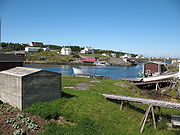
Change Islands
Encyclopedia
Change Islands is an outport
community in the Canadian
province of Newfoundland and Labrador
.
The community spans two small islands of the same name which lie off the northeast coast of the island of Newfoundland between Notre Dame Bay
and the Labrador Sea
.
The community of Change Islands is located primarily on the larger South Island, today hosting approximately 200 residents, though most of the public buildings are on the North Island.
, in Newfoundland English
).
The South Island is larger, containing more marsh
es/bog
s, and wooded area, the North Island is smaller, mostly barren. It is located in Notre Dame Bay
, on the northeast coast of the island of Newfoundland.
The community was first established as a series of random settlements around the islands tied to seasonal fishing activity which developed into a cohesive community. The first European settlers arrived sometime in the mid-18th century to fish.
The residents of Change Islands have preserved many of their traditional homes, stages
, and stores (fishing sheds); many of these landmarks are disappearing in much of coastal Newfoundland and Labrador with the collapse of the ground fishery.
There are a few accommodation facilities on the islands which are accessible by the provincially-operated ferry service from Farewell that also services Fogo Island further to the east.

Newfoundland outport
An outport is the term given for a small isolated coastal community in the Canadian province of Newfoundland and Labrador. Originally the term was just used for coastal communities on the island of Newfoundland but the term has also been adopted for those on the mainland area of Labrador as...
community in the Canadian
Canada
Canada is a North American country consisting of ten provinces and three territories. Located in the northern part of the continent, it extends from the Atlantic Ocean in the east to the Pacific Ocean in the west, and northward into the Arctic Ocean...
province of Newfoundland and Labrador
Newfoundland and Labrador
Newfoundland and Labrador is the easternmost province of Canada. Situated in the country's Atlantic region, it incorporates the island of Newfoundland and mainland Labrador with a combined area of . As of April 2011, the province's estimated population is 508,400...
.
The community spans two small islands of the same name which lie off the northeast coast of the island of Newfoundland between Notre Dame Bay
Notre Dame Bay
Notre Dame Bay is a large bay in Newfoundland, Canada. To the south it adjoins the Bay of Exploits.The name, French for Our Lady Bay, dates to at least 1550, and is possibly a French translation of an earlier Portuguese name....
and the Labrador Sea
Labrador Sea
The Labrador Sea is an arm of the North Atlantic Ocean between the Labrador Peninsula and Greenland. The sea is flanked by continental shelves to the southwest, northwest, and northeast. It connects to the north with Baffin Bay through the Davis Strait...
.
The community of Change Islands is located primarily on the larger South Island, today hosting approximately 200 residents, though most of the public buildings are on the North Island.
Geography
The southern and northern Change Islands are separated by a "tickle" (a narrow straitStrait
A strait or straits is a narrow, typically navigable channel of water that connects two larger, navigable bodies of water. It most commonly refers to a channel of water that lies between two land masses, but it may also refer to a navigable channel through a body of water that is otherwise not...
, in Newfoundland English
Newfoundland English
Newfoundland English is a name for several accents and dialects thereof the English found in the province of Newfoundland and Labrador. Most of these differ substantially from the English commonly spoken elsewhere in Canada...
).
The South Island is larger, containing more marsh
Marsh
In geography, a marsh, or morass, is a type of wetland that is subject to frequent or continuous flood. Typically the water is shallow and features grasses, rushes, reeds, typhas, sedges, other herbaceous plants, and moss....
es/bog
Bog
A bog, quagmire or mire is a wetland that accumulates acidic peat, a deposit of dead plant material—often mosses or, in Arctic climates, lichens....
s, and wooded area, the North Island is smaller, mostly barren. It is located in Notre Dame Bay
Notre Dame Bay
Notre Dame Bay is a large bay in Newfoundland, Canada. To the south it adjoins the Bay of Exploits.The name, French for Our Lady Bay, dates to at least 1550, and is possibly a French translation of an earlier Portuguese name....
, on the northeast coast of the island of Newfoundland.
The community was first established as a series of random settlements around the islands tied to seasonal fishing activity which developed into a cohesive community. The first European settlers arrived sometime in the mid-18th century to fish.
The residents of Change Islands have preserved many of their traditional homes, stages
Fishing stage
A fishing stage is a wooden vernacular building, typical of the rough traditional buildings associated with the cod fishery in Newfoundland, Canada. Stages are located at the water's edge or "landwash", and consist of an elevated platform on the shore with working tables and sheds at which fish...
, and stores (fishing sheds); many of these landmarks are disappearing in much of coastal Newfoundland and Labrador with the collapse of the ground fishery.
There are a few accommodation facilities on the islands which are accessible by the provincially-operated ferry service from Farewell that also services Fogo Island further to the east.

See also
- Fishing stageFishing stageA fishing stage is a wooden vernacular building, typical of the rough traditional buildings associated with the cod fishery in Newfoundland, Canada. Stages are located at the water's edge or "landwash", and consist of an elevated platform on the shore with working tables and sheds at which fish...
- List of cities and towns in Newfoundland and Labrador

